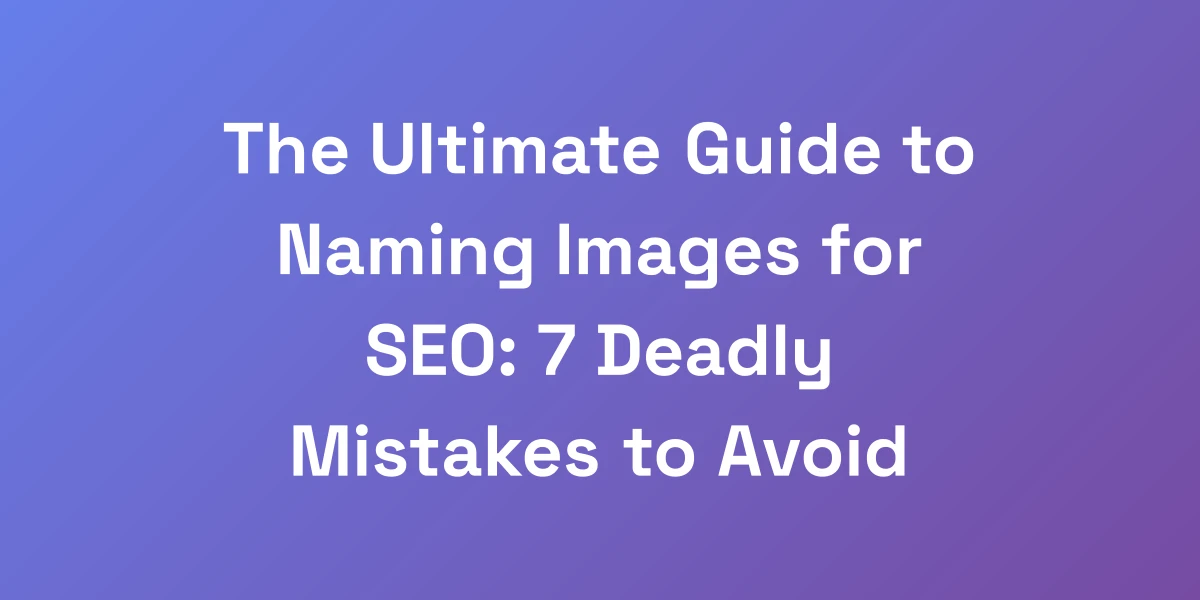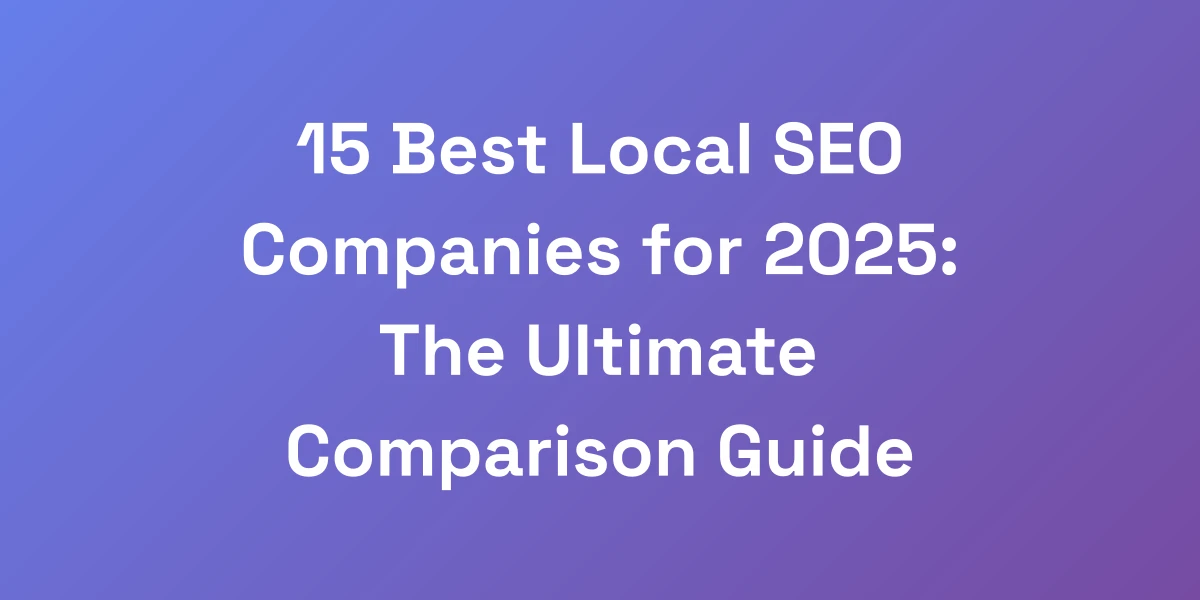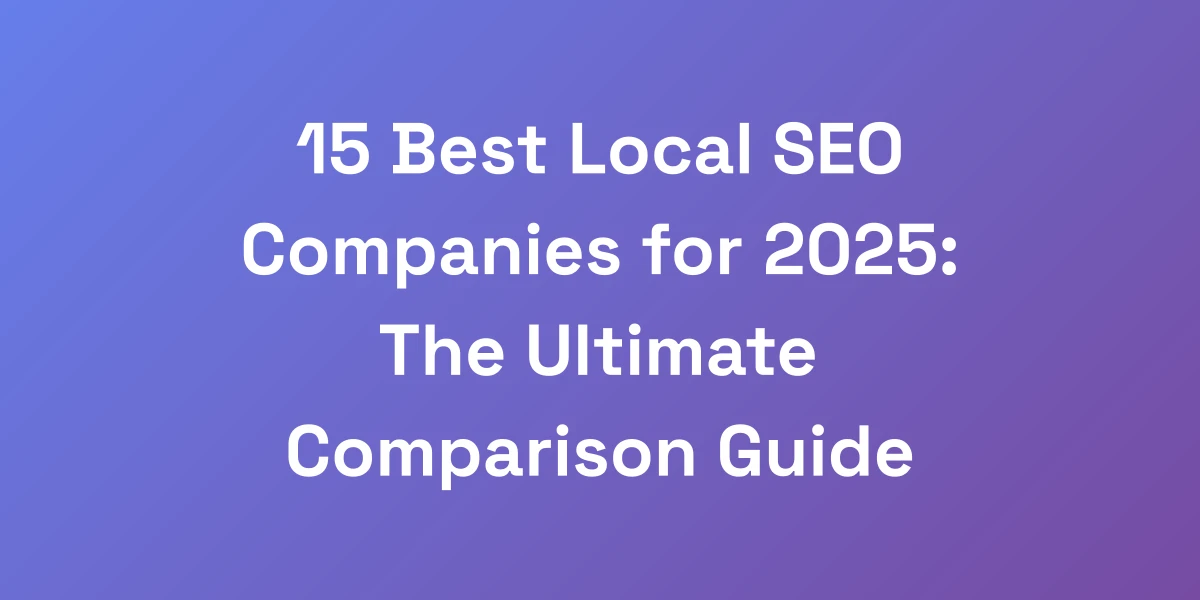
The Ultimate Guide to Naming Images for SEO: 7 Deadly Mistakes to Avoid
Mar 13, 2025 | By [email protected]
Introduction
Let’s get straight to it: if you’re not naming your images for SEO, you’re leaving organic traffic on the table. We’ve analyzed thousands of websites, and the truth is glaring—most business owners are unaware of how significant image naming can be for their SEO strategy.
Imagine having high-quality images on your site, drawing in users and converting them into customers, but all the while, those images aren’t contributing to your search rankings. It’s like having an incredible product with no storefront. This oversight isn’t just a minor hiccup—it’s a substantial leak in your traffic funnel.
Struggling with poor image names might sound trivial, but it’s a game of inches in the highly competitive SEO landscape. The challenges we’re talking about go beyond simply slapping a few keywords onto filenames. We’re diving deep into how strategic image naming can make or break your visibility online.
Ready to transform your approach and harness the true power of your images? Let’s uncover the secrets the top 1% use to dominate search results and ensure your images are driving traffic, engagement, and conversions like never before.
Why 99% of Websites Are Bleeding Traffic Due to Poor Image Names
The Hidden Cost of Bad Image Names
We all underestimate the impact of image names. Bad naming isn’t just a cosmetic issue—it’s a silent traffic killer. When images are named generically like “IMG_001.jpg,” search engines have no clue about the content or relevance, which means missed opportunities for ranking in image search results.
Moreover, these generic names fail to communicate with users, reducing the likelihood of clicks and engagement. It’s a win-win misstep: losing visibility and not engaging your audience effectively.
How Google Actually Reads Your Image Names
Google doesn’t see images the way we do. It relies heavily on the metadata associated with each image, including the filename, alt text, and surrounding content. When you name your image with relevant keywords, you’re telling Google exactly what the image is about.
This isn’t just about stuffing keywords into filenames. It’s about crafting descriptive, meaningful names that align with the content and purpose of the image, enhancing both your SEO and user experience.
For specific industries like hotel SEO, optimized image naming can significantly boost your search rankings in a highly competitive market.
The SEO Power Multiplier Effect
Proper image naming acts as a multiplier for your overall SEO strategy. It enhances keyword relevance, boosts the contextual understanding of your pages, and improves user engagement metrics like time on page and click-through rates.
When every image on your site is optimized correctly, you create a network of search-engine-friendly assets that collectively elevate your site’s authority and ranking potential, similar to how best backlinking services enhance your website authority.
Real Numbers: Traffic Loss from Poor Image Naming
Did you know that Google Image Search alone now comprises about 20% of all search engine traffic? Imagine the traffic you’re losing by neglecting image naming. Even a small percentage of this traffic can translate to thousands of lost visitors annually.
Furthermore, nearly half of online shoppers say images help them make a purchase decision. Poorly named images not only hurt your SEO but also your conversion rates by failing to attract and engage potential customers effectively.
The Psychology Behind Effective Image Names
Effective image names tap into how humans and search engines perceive and categorize content. Descriptive, keyword-rich filenames align with user search intent, making your images more discoverable and relevant.
Additionally, having a strong content marketing lead skills can help you develop strategies that align image optimization with broader content goals, enhancing both search visibility and user satisfaction.
The 7 Deadly Sins of Image Naming (And How to Fix Them)
Generic Filenames (IMG_001.jpg)
Using generic filenames like “IMG_001.jpg” is the easiest way to sabotage your SEO efforts. These names provide no context or relevance, making it impossible for search engines to understand the image’s purpose.
How to Fix It: Replace generic names with descriptive, keyword-rich filenames. For example, instead of “IMG_001.jpg,” use “red-running-shoes-men.jpg” to clearly describe the image content.
Keyword Stuffing Disasters
While keywords are crucial, overloading filenames with them can backfire. Keyword stuffing makes filenames look spammy and can lead to penalties from search engines.
How to Fix It: Use keywords naturally and focus on relevance. Limit your filenames to essential descriptors that accurately reflect the image content without overdoing it.
Space and Special Character Chaos
Spaces and special characters in filenames can disrupt readability for search engines. For instance, “fitness class 2023.jpg” is less effective than “fitness-class-2023.jpg.”
How to Fix It: Use hyphens to separate words and avoid spaces and special characters. This ensures better readability and indexing by search engines.
Overly Long Filenames
Long filenames can be cumbersome and may get truncated in search results, reducing their effectiveness. For example, “this-is-an-excessively-long-filename-for-an-image-that-should-be-optimized.jpg” is a nightmare.
How to Fix It: Keep filenames concise yet descriptive. Aim for clarity without unnecessary length, balancing detail with brevity.
Irrelevant Keyword Usage
Including irrelevant keywords in filenames can confuse search engines and mislead users. It dilutes the relevance and can harm your SEO rather than help it.
How to Fix It: Ensure that all keywords used are directly related to the image content. Relevance is key to maintaining both SEO integrity and user trust.
Missing Context in Names
Filnames that lack context fail to provide meaningful information about the image. Without context, search engines and users cannot understand the relevance or purpose of the image.
How to Fix It: Add contextual information to filenames. For example, instead of “banner.jpg,” use “summer-sale-banner-2024.jpg” to provide context.
Inconsistent Naming Conventions
Inconsistent naming makes it harder to manage and optimize images at scale. It leads to confusion and inefficiency in your SEO efforts.
How to Fix It: Establish and stick to a consistent naming convention. Whether it’s using hyphens, underscores, or a specific order of keywords, consistency is crucial for effective image management.
The Perfect Image Naming Framework That Gets Results
The 5-Word Rule for Maximum Impact
We’ve found that sticking to the 5-word rule strikes the perfect balance between detail and brevity. Five words are enough to describe the image accurately without being overly verbose.
For example, “blue-widgets-inventory-warehouse.jpg” is descriptive yet concise, making it easy for search engines to understand and index.
Primary-Secondary Keyword Structure
Structuring filenames with primary and secondary keywords enhances their SEO value. Start with the primary keyword and follow it with secondary descriptors.
For instance, “organic-coffee-beans-250g.jpg” uses “organic coffee” as the primary keyword and adds “beans 250g” as secondary descriptors, improving relevance and searchability.
Industry-Specific Naming Patterns
Different industries have unique requirements and naming conventions. Tailoring your image names to fit industry-specific patterns can significantly boost SEO.
In e-commerce, for example, including product type, color, and size can be highly effective, like “men’s-black-leather-jacket-medium.jpg.”
Scalable Naming Conventions
Your naming conventions should grow with your business. Scalability ensures that as you add more images, your system remains organized and efficient.
Create a framework that allows for easy additions, such as including categories, dates, or other relevant identifiers that can accommodate growth without chaos.
Automation Tools and Processes
Managing large numbers of images manually is impractical. Automation tools can streamline the naming process, ensuring consistency and saving time.
Tools like Kraken.io, ShortPixel, or Diff Checker offer batch processing capabilities, enabling you to rename and optimize images efficiently.
Quality Control Checklist
Maintaining quality is essential. Develop a quality control checklist to ensure every image name meets your SEO standards before publishing.
Check for keyword relevance, proper use of hyphens, appropriate length, and consistency with your naming conventions. This step ensures that every image is optimized correctly.
Advanced Image SEO Tactics Beyond Just Names
Alt Text Optimization Secrets
Alt text is a crucial component of image SEO. It not only helps search engines understand the image content but also enhances accessibility for visually impaired users.
How to Optimize: Write clear, descriptive alt text that incorporates relevant keywords naturally. Avoid keyword stuffing and focus on accurately describing the image’s content and purpose.
For example, instead of “image1,” use “handcrafted wooden dining table with chairs.” This approach provides context and improves your SEO.
Image Context Positioning
The position of an image within your content plays a significant role in its SEO effectiveness. Images placed near relevant text are more likely to be indexed correctly and improve the overall relevance of the page.
Best Practices: Position images close to descriptive text or headings that relate to the image content. This helps search engines understand the context and enhances the user experience.
For instance, an image of a “blue-running-shoe” should be placed near a paragraph discussing running gear or footwear options.
Schema Markup for Images
Schema markup provides additional context to search engines about the content of your images. Implementing appropriate schema can enhance your image visibility in search results.
Implementation Tips: Use relevant schema types such as Product, Recipe, or Article to provide detailed information about your images.
For example, a product image can be marked up with Product schema, including details like name, price, and availability, which can improve its appearance in rich snippets.
Image Sitemap Strategies
Including images in your sitemap helps search engines discover and index your images more efficiently. This ensures that all your optimized images are accounted for in search results.
How to Implement: Create and submit an image sitemap or include image information in your existing sitemap. Ensure that all important images are included and that the sitemap is kept up to date.
This step can significantly boost your image SEO by making search engines aware of all your visual content.
CDN and Loading Speed Optimization
Image loading speed is a critical factor for both user experience and SEO. Slow-loading images can increase bounce rates and negatively impact your search rankings.
Optimization Techniques: Utilize Content Delivery Networks (CDNs) to deliver images faster and use compression tools to reduce file sizes without compromising quality.
Tools like Kraken.io or ShortPixel can help you optimize images for faster loading times, enhancing both user satisfaction and SEO performance.
Mobile-First Image Optimization
With the majority of searches happening on mobile devices, optimizing images for mobile is non-negotiable. Mobile-first indexing prioritizes content tailored for mobile users, including images.
Best Practices: Ensure that your images are responsive, use appropriate sizes for different devices, and maintain fast loading speeds. This improves the user experience and aligns with Google’s mobile-first indexing approach.
Implementing these practices ensures that your images contribute positively to your site’s mobile SEO performance.
Implementation and Scaling Strategies
Batch Renaming Tools and Techniques
Scaling your image optimization requires efficient tools. Batch renaming tools allow you to rename multiple images quickly, ensuring consistency across your entire site.
Recommended Tools: Tools like Kraken.io, ShortPixel, and Optimizilla offer robust batch processing capabilities, allowing you to manage large volumes of images effortlessly.
By automating the renaming process, you save time and reduce the risk of human error, maintaining a high standard across all your images.
Team Training and SOPs
Consistency is key when it comes to image naming. Training your team and establishing Standard Operating Procedures (SOPs) ensures that everyone follows the same guidelines, maintaining uniformity.
Action Steps: Develop comprehensive training materials that outline your naming conventions and optimization strategies. Regularly update these materials to reflect any changes or improvements in your approach.
Having a well-trained team ensures that your image optimization efforts are sustained and scalable, supporting long-term SEO success.
Quality Assurance Processes
Maintaining quality across all your images is essential for ongoing SEO performance. Implementing quality assurance processes ensures that every image meets your optimization standards before it goes live.
How to Implement: Create checklists that cover all aspects of image optimization, including filename accuracy, alt text quality, and proper formatting. Regular audits can help identify and rectify any inconsistencies or issues.
Quality assurance processes ensure that your images consistently contribute positively to your SEO efforts.
Monitoring and Tracking Results
To gauge the effectiveness of your image optimization strategies, it’s crucial to monitor and track your results. Use analytics tools to measure the impact of optimized images on traffic and engagement.
Key Metrics: Track metrics such as image search traffic, click-through rates, and conversion rates. Analyzing these metrics helps you understand what’s working and where improvements are needed.
Regular monitoring allows you to make data-driven decisions, refining your strategies for maximum impact.
Maintenance and Updates
SEO is not a one-time effort. Regular maintenance and updates ensure that your image optimization strategies stay effective amidst evolving search engine algorithms and industry trends.
Best Practices: Periodically review and update your image names, alt texts, and other SEO elements. Stay informed about the latest SEO trends and adjust your strategies accordingly.
If you need external support, partnering with digital advertising companies in India can provide you with the expertise required to scale your image optimization efforts.
Scaling Across Multiple Sites
For businesses managing multiple websites, scaling image optimization can be challenging. Implementing a systematic approach is essential for maintaining consistency and efficiency across all sites.
Strategies: Develop centralized naming conventions and optimization guidelines that can be applied uniformly across all sites. Use automation tools to handle bulk optimizations, ensuring that every site benefits from your image SEO strategies.
Scaling effectively allows you to maximize the SEO potential of all your websites, driving traffic and engagement consistently.
Conclusion
We’ve unpacked the critical role of image naming in SEO and revealed the seven deadly mistakes that could be draining your website’s traffic. By understanding the hidden costs and leveraging our perfect image naming framework, you can transform your SEO strategy and unlock significant traffic gains.
Don’t let poor image names hold you back. Start implementing these strategies today and watch your search rankings and traffic soar. Remember, every image is an opportunity to enhance your SEO—don’t miss out on these powerful gains.
Ready to optimize your images for maximum SEO impact? Take action now and start naming your images strategically to dominate search results and drive meaningful traffic to your site.
We’d love to hear about your experiences with image optimization. Share your thoughts and any questions you have in the comments below—let’s elevate our SEO game together!








